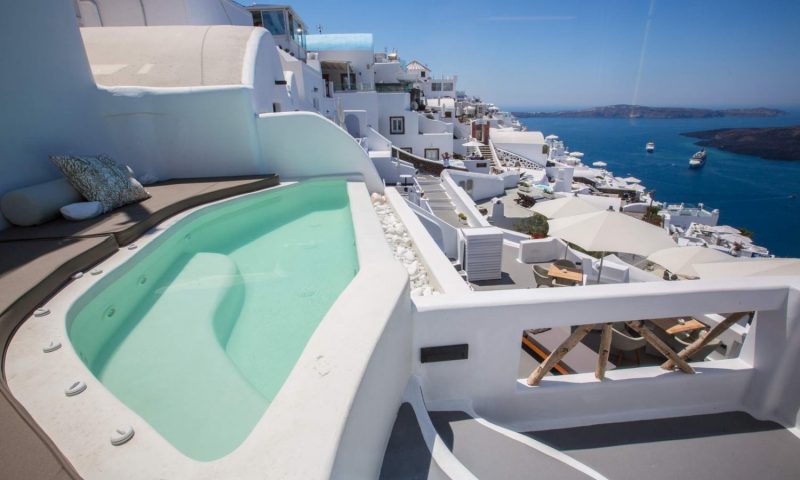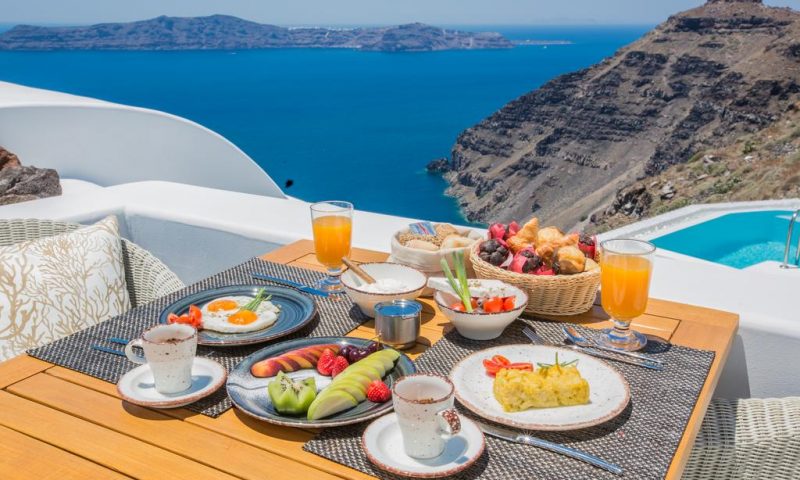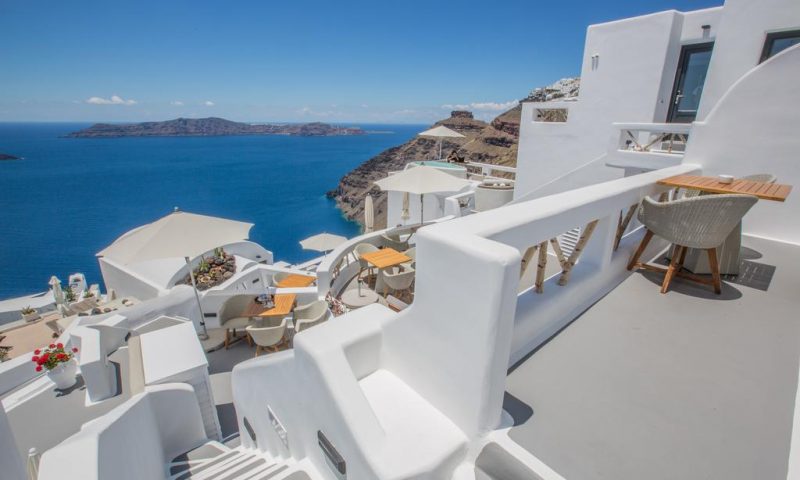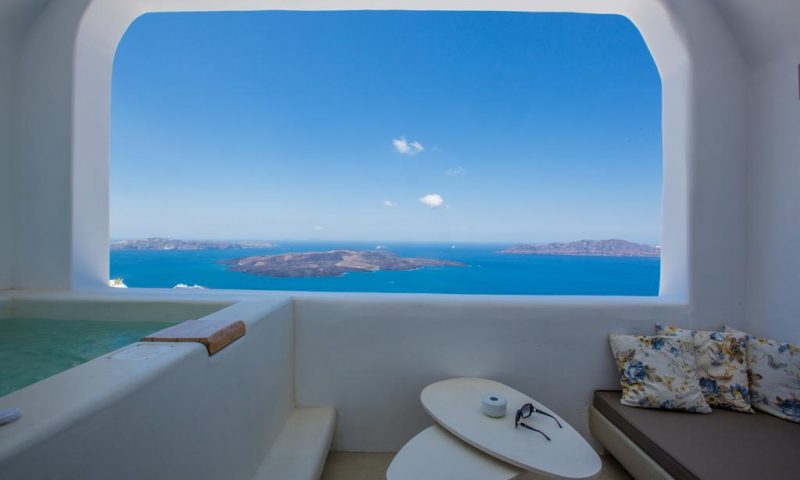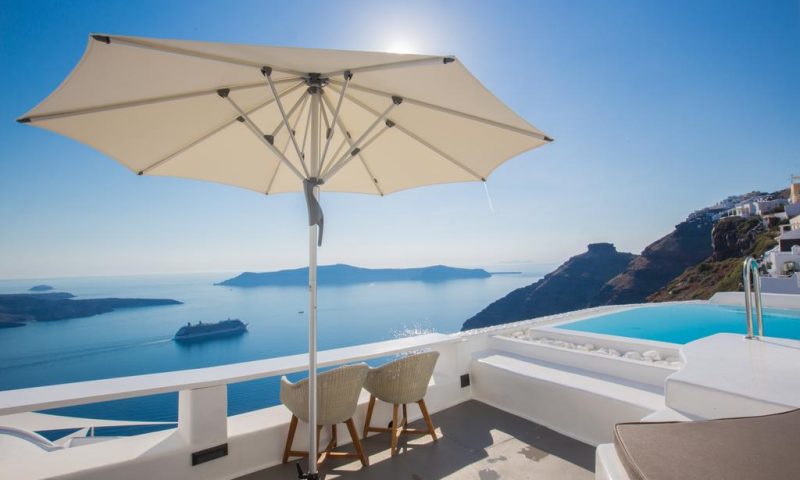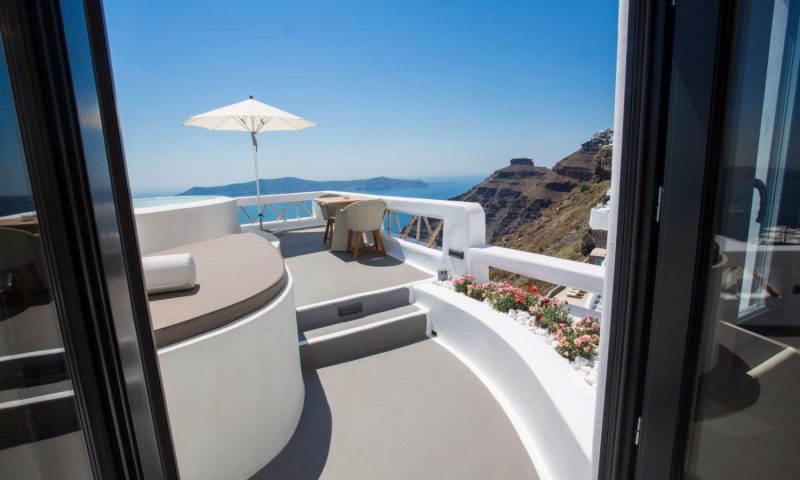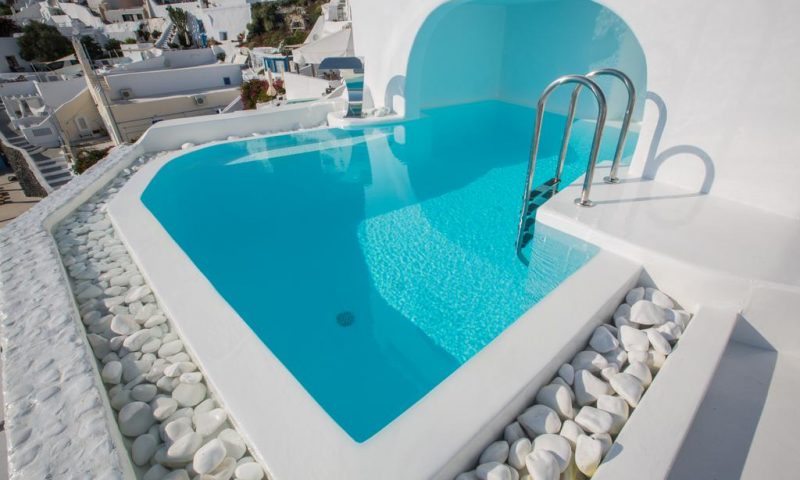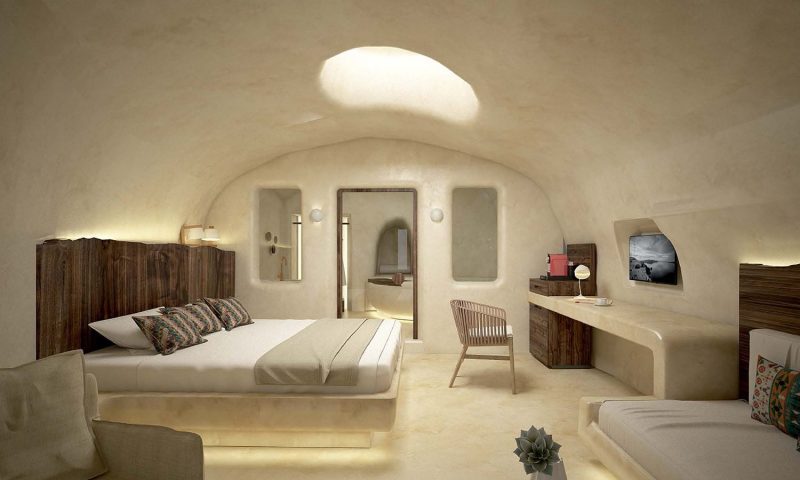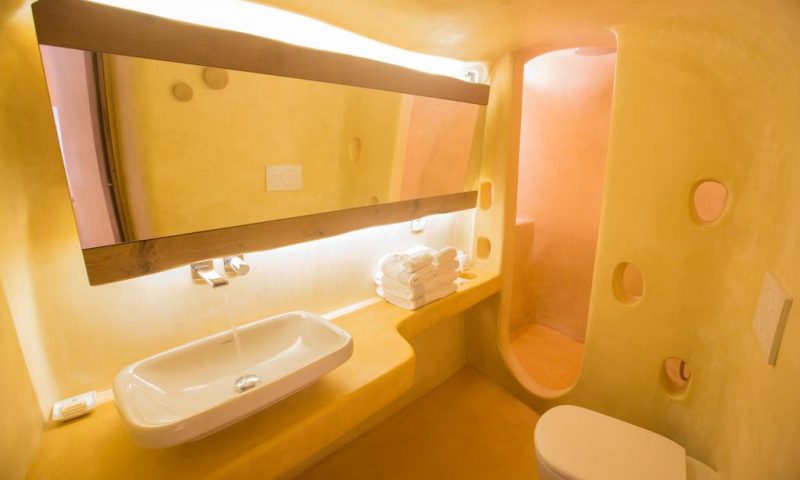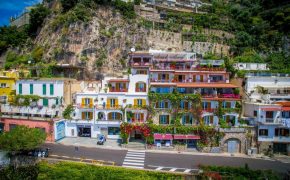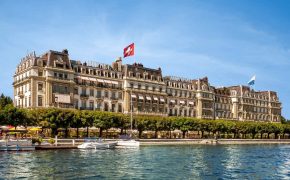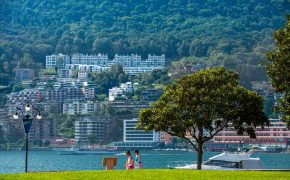Santorini Chic Hotel is an elegant, luxurious and excellently located hotel in the peaceful village of Firostefani, with astonishing views of the Volcanic islets and the Caldera, only 5 minutes walking distance from the island’s capital, Fira.
All accommodations are with air conditioning, Cable-Satellite LED TV, direct dial phone, safe deposit boxes, hairdryer, Bathrobes and Slippers, a lavishly appointed mini bar, Internet access, other comfort amenities.
Easily accessible via Air and Boat transportation, 9 Km. from Santorini Airport and Athinios Port.
BEACHES
Red Beach
The red beach is arguably one of the most famous and beautiful beaches of Santorini. It is located only some steps away from the ancient site of Akrotiri.
The small size of the beach creates a much crowded atmosphere and there are many days where most of the visitors choose not to make it all the way down to the beach and instead admire this unique landscape of red and black volcanic rocks from the headland.
The access is relatively easy. You can leave your car at the parking space and continue all the way down that takes about two minutes. As you gradually get down to the beach you will be impressed by the different colorings of the cliffs.
Many sunbeds and umbrellas cover the dark sand and right on the seashore are some nice pebbles you can use for your collection. Snorkeling is highly recommended due to the interesting rocks. You can also access the beach by boat that departs from Akrotiri port.
Kamari
Kamari is a famous beach resort of Santorini situated 10 km southeast of Fira, the island’s capital. Quite similar to the landscape of Perissa, the beach is covered by black sand while on the left side of the beach is an enormous rock called Mesa Vouno that rises from the sea.
The area is extremely attractive, especially at night when the rock shines in the dark. The beach of Kamari is fully organised offering a wide range of facilities like sunbeds, umbrellas and various types of water sports.
The traditional houses line the village of Kamari offering a beautiful view to the sea. Visitors can take a nice walk along the waterfront.
Due to the modern amenities including hotels, restaurants, snacks, cafes, bars and night clubs the village becomes quite popular with tourists during the peak season. From Kamari, a road takes you up the mountain to Ancient Thira, and a caique can bring you to the wild isle of Anafi.
Perissa
Perissa is a beautiful beach situated 15 km southeast of Fira extending for 7 km on the southeastern side of Santorini. The beach features unique charateristics, black sand, crystalline waters and various beach facilities.
However, the enormous rock called Mesa Vouno that rises from the sea is the main attraction of the beach and the entire area. Visitors are left spellbound by the stunning view of the rock especially when it shines in the dark.
Perissa is a nice tourist resort witnessing a huge tourist movement that starts from in the middle of the summer season. The village offers a great variety of hotels for all tastes and budgets, restaurants, taverns, cafes and bars.
The area is extremely developed with modern amenities and quite inviting while retaining its strong traditional character. From Perissa, a small path crosses the mountain and leads to the ruins of Ancient Thera. The excursions can be made by foot or riding donkeys.
Perivolos
The picturesque beach of Perivolos is ideally located in close proximity to Perissa which is a mere 3 km away. This beautiful beach of Santorini lies on the southern end of the island. The beach distinguishes for its sparkling azure blue waters and tranquil atmosphere.
On the beachfront there are numerous taverns, pubs and restaurants serving fresh fish and local delicacies. Perivolos beach is easily reachable from Perissa. In case you don’t have your own vehicle, there are local buses and cabs that will take you there.
Those who like to walk can also choose the path that passes through the countryside. Perivolos is basically a continuation from the beach of Perissa and Agios Georgios.
Perivolos is surely one of the most well- organized beaches of Santorini offering a plethora of exciting water sports facilities, like windsurfing, scuba diving and jet ski.
Vlychada
The beach follows a smooth descent. You will notice as you approach two large chimneys. One is directly behind the beach and one nearby, but don’t worry as this factory is no longer in use and the brick structures are actually quite pleasant to look at.
This beach of Santorini itself is quite long covered with dark grey sand that one finds all over the island. There are a number of sun loungers here. It is worth having a look at the rock formations behind the beach which are quite interesting.
Agios Georgios
One of the most famous black beaches of Santorini, Agios Georgios receives many tourists. It is located about 3.5 km away from Perissa, and it provides an exciting option for all visitors. Numerous facilities are available such as umbrellas and seats for rent, hotels and bars that fit every budget.
Visitors can choose among a variety of activities in the water or out at the beach. A large number of restaurants and taverns are gathered along the waterfront, covering all tastes.
The beach is a haven for water sport enthusiasts, offering them a wide range of water activities to choose from, including Jet- skiing, scuba-diving, windsurfing, paddle boats and banana boats. Agios Georgios beach is clearly an ideal holiday spot.
Cape Columbo
The most isolated spot in Santorini, 10 km from Fira, the island’s capital. While reaching Columbo you can park on the headland in two different positions and make your way down through a narrow path.
The impressive yet dramatic landscape will amaze you. The enormous red cliffs offer enough shade. Around the area is the most active crater of the island and the waters are really hot. Visitors should carry some water while there is no cantine or restaurant nearby.
Monolithos
The beach of Monolithos is close to the beach of Kamari, in the area near the airport of Santorini. It is quite popular among the locals and especially families. It is long with black sand and shallow waters, well-organized with sunbeds and umbrellas.
This beach reveals a pleasant atmosphere, that is why it is often crowded with children. The area is surrounded by various hotels and rooms, restaurants and cafes. There is a football pitch, basketball court and for children a nice play area. There are also trees at the back of the beach for shade seekers.
White Beach
The cove right next to the Red beach, on the southern side of Santorini, is known as the White beach. It is very similar to the Red beach, with black pebbles on the shore, only that the surrounding cliffs are white.
This beach is accessible by boat or on foot from the Red beach. It is less popular than the neighbouring cove and therefore more quiet. It doesn’t have facilities, except for some umbrellas and sunbeds along the coast, although the surrounding rocks provide some shade too.
Vourvoulos
Vourvolos beach is located 7 km from Fira, at the northeastern side of Santorini. This sandy beach is ideal for relaxation and water is almost turquoise blue. Vourvoulos beach is among the lesser known beaches of Santorini totally isolated providing relaxation and privacy.
You can also the visit the village of Karterados, a charming area with beautiful buildings. Unfortunately, Vourvoulos beach is not well maintained and the beach is full of garbage and trash.
Also, it is a fact that the sea breeze here is very blustery which makes sun bathing at the beach to be a dangerous proposition. The waves too are huge and it is always advisable to be at a safe distance from the shoreline. Vourvoulos beach is ideal for one who wants to spend quiet holidays.
VOLCANO
Santorini is gifted with a unique natural beauty and a wild scenery created by the volcanic eruptions.
As it is extremely famous for the beautiful caldera, the island is also known for the two small islands of black lava positioned at the center of the basin of Santorini, which are, geographically, the youngest islets in the Eastern Mediterranean.
Nea Kameni especially is a pole of attraction for tourists for its healing hot springs. The yellow waters there contain a large amount of sulfur and are characterized for their therapeutic purposes. Today, Agios Nikolaos which is the small cove in Nea Kameni islet is a true health source.
Santorini villages perched on high cliffs offer a breathtaking view to the caldera and the young islets, especially during the amazingly colored sunset. Tourists can visit the volcano by taking one of the daily cruises advertised in any village.
One can walk upon the solid black lava sides of the steaming volcano and explore the whole area, which is quite impressive.
Nea Kameni is the central one, and once on its shore, after a walk of 20 minutes in the lunar scenery, visitors will discover the volcano’s crater and other openings bursting with sulfur steam.
The area also offers an incredible view of the beautiful villages hanging on the cliffs. The oldest volcano, Palea Kameni also has hot springs.
The volcanic complex of Santorini is the most active part of the South Aegean Volcanic Arc, which includes the volcanoes of Methana, Milos, Santorini and Nisyros.
It marks the subduction of the African tectonic plate underneath the Aegean subplate of the Eurasian tectonic plate, at a rate of up to 5 cm per year in a northeasterly direction. It is characterized by earthquakes at depths of 150–170 km.
Non-volcanic rocks are exposed on Santorini at the Profitis Ilias Mountain, Mesa Vouno, the Gavrillos ridge, Pirgos, Monolithos and the inner side of the caldera wall between Cape Plaka and Athinios. The Kameni islands at the center of the caldera are made of lava rocks.
The caldera is composed of overlapping shield volcanoes, cut by at least four partially overlapping calderas, of which the oldest southern caldera was formed about 180,000 years before the present era (BP).
The subsequent Skaros caldera was created about 70,000 years BP, and the Cape Riva caldera about 21,000 years BP. The current caldera was formed about 3600 years BP during the Minoan eruption. Palea Kameni and Nea Kameni were formed as a result of multiple, initially submarine eruptions at the center of the caldera.
Although dormant, Santorini is an active volcano. Numerous minor and medium-sized, mainly effusive eruptions have built the dark-colored lava shields of Nea and Palea Kameni inside the caldera.
Their last eruption was in 1950, and now only fumarolic activity, primarily inside the recently active craters, takes place. GPS instruments have registered renewed deformation around the caldera in 2011 and 2012.
The huge Minoan eruption of Santorini in the 17th century BC may have inspired the legend of Atlantis. It was rated 7, the highest score for a historical eruption, in the Smithsonian Global Volcanism Program’s Volcanic Explosivity Index.
WINE
Santorini is a Greek wine region located on the archipelago of Santorini in the southern Cyclades islands of Greece. Wine has been produced there since ancient times, but it was during the Middle Ages that the wine of Santorini became famous worldwide under the influence of the Republic of Venice.
The Italian influence is still present in modern Santorini winemaking: the most famous Tuscan sweet wine is called Vin Santo. Santorini’s Vin Santo (labeled “Vinsanto” to differentiate it from the Tuscan wine) is made in a passito style from grapes dried in the sun after harvest. Santorini also produces blended and rosé wine made from white grapes such as Athiri, Aidini and Assyrtiko, and red grapes such as Mandelaria.
In its early geological history, Santorini was the core of an ancient volcano that erupted in about 1640–1620 BC. A large part of the island became submerged, creating the modern day archipelago.
Wine was made on the island in Greek and Roman times, but the region became particularly noteworthy in the Middle Ages when Crusaders captured control of the island from the Byzantine empire after Constantinople was sacked in 1203.
One of the crusaders was a Venetian nobleman whose family maintained control of the island until 1336 when it became part of the Venetian maritime state Duchy of Naxos.
Under the Venetian influence, with this extensive trade network and maritime control, Santorini wines were widely exported throughout the Mediterranean and Europe. The wine was particularly prized for its ability to withstand the month long sea voyages due, in part, to its sweetness and high alcohol levels.
So highly valued was Santorini wines during this period that when the Ottoman Turks captured the region in 1579, they still permitted the uninterrupted trade of the wine even though the religious edicts of their Muslim faith generally forbids alcohol.
One explanation for the Turks concession was that the poor soil and perilous topography of the island, with cliffs running right to the sea, made the cultivation of other cash crops difficult.
When the Russian Orthodox Church adopted Santorini wine as the official Eucharistic wine of the church, the Ottomans allowed the island producers to trade freely with Russia even during the frequent wars between the two empires

